Investigating the Tradeoffs between Power Consumption and Quality of Service in a Backbone Network
Abstract
:1. Introduction
2. Previous Work
3. Trading Power Consumption against QoS
- Understand the drawbacks of introducing sleep modes in the network;
- Identify the required operating state of the network based on power consumption savings requirements and QoS constraints;
- Provide the basis for future mathematical models of the behaviour of such a system;
- Facilitate pricing techniques depending on QoS demands and the cost of power needed for these constraints to be guaranteed.
3.1. Proposed Mechanism
- An enhanced neighbour-discovery mechanism for rapidly establishing whether a node’s immediate neighbours are ON or OFF;
- A queue for storing packets at the previous hop if a node is suspended.
- When a packet is ready to be sent from a node, the state of the next hop is checked;
- If the next hop is ON then the packet is processed and sent out immediately;
- If the next hop is OFF the mechanism searches whether a storage queue exists for this hop.
- −
- if there is no queue, a new queue is created for this missing hop and the packet is stored;
- −
- if there is already a queue for this missing hop, the packet is simply placed at its end.
- Sending frequent hello messages to inform the node’s neighbours that it is ON;
- Keeping a state table of all its neighbours based on the hello messages it receives;
- Keeping the timestamp of the last hello message received from each neighbour;
- Removing a neighbour from the list if no hello messages have been received within a time-out interval;
- Re-adding a neighbour to the list when it wakes up from a sleep state;
- Processing the queue and sending out all the corresponding packets for a recently added neighbour;
- Informing the queuing mechanism which neighbours are ON (or not) based on the state tables of the neighbours.
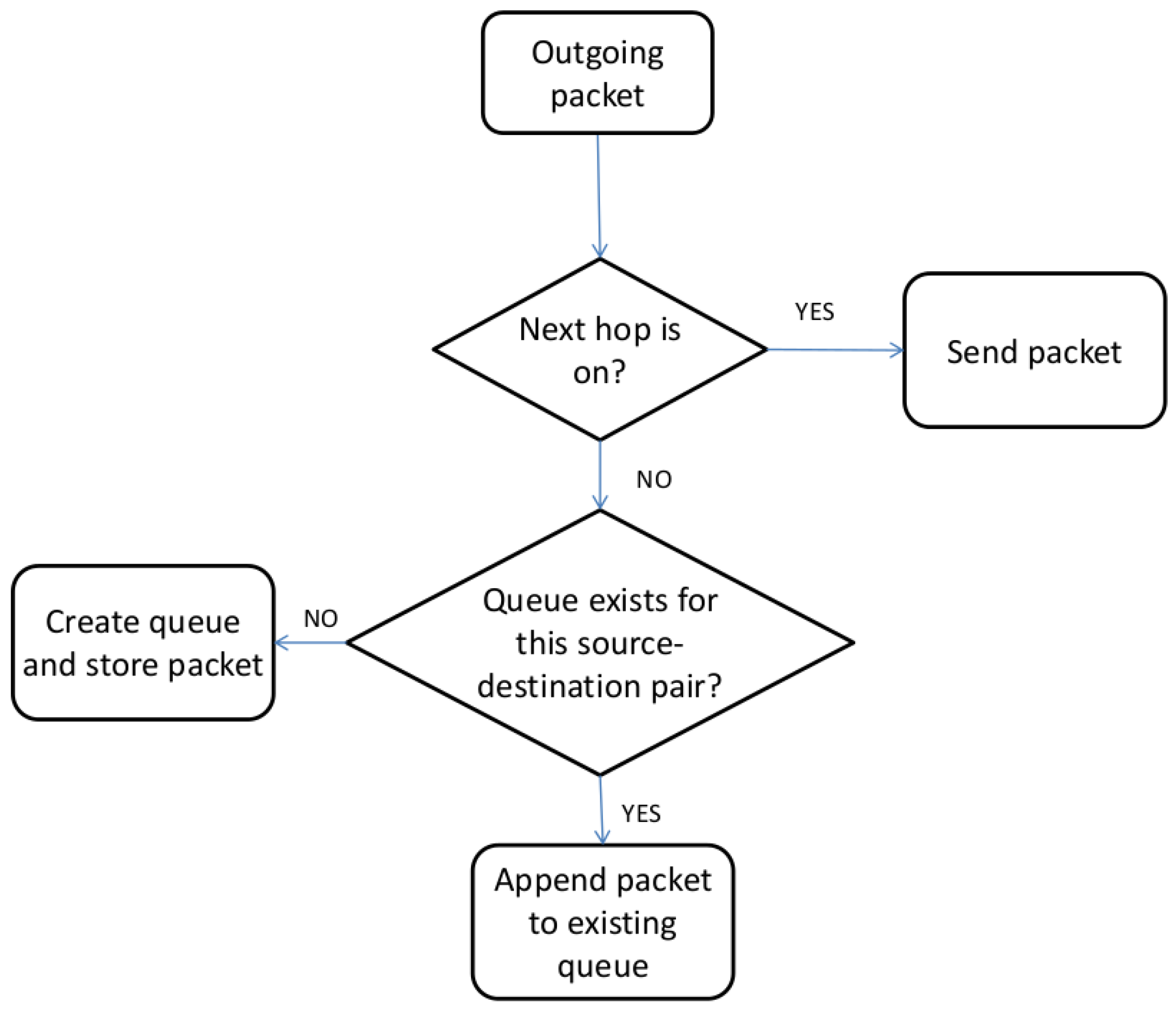
4. Experiments

| (s) | (s) | (s) | (s) | |
|---|---|---|---|---|
| experiment 1 | the nodes are always OFF | |||
| experiment 2 | 5 | 10 | 5 | 30 |
| experiment 3 | 5 | 15 | 5 | 25 |
| experiment 3 | 5 | 20 | 5 | 20 |
| experiment 5 | 5 | 25 | 5 | 15 |
| experiment 6 | 5 | 30 | 5 | 10 |
| experiment 7 | the nodes are always ON |

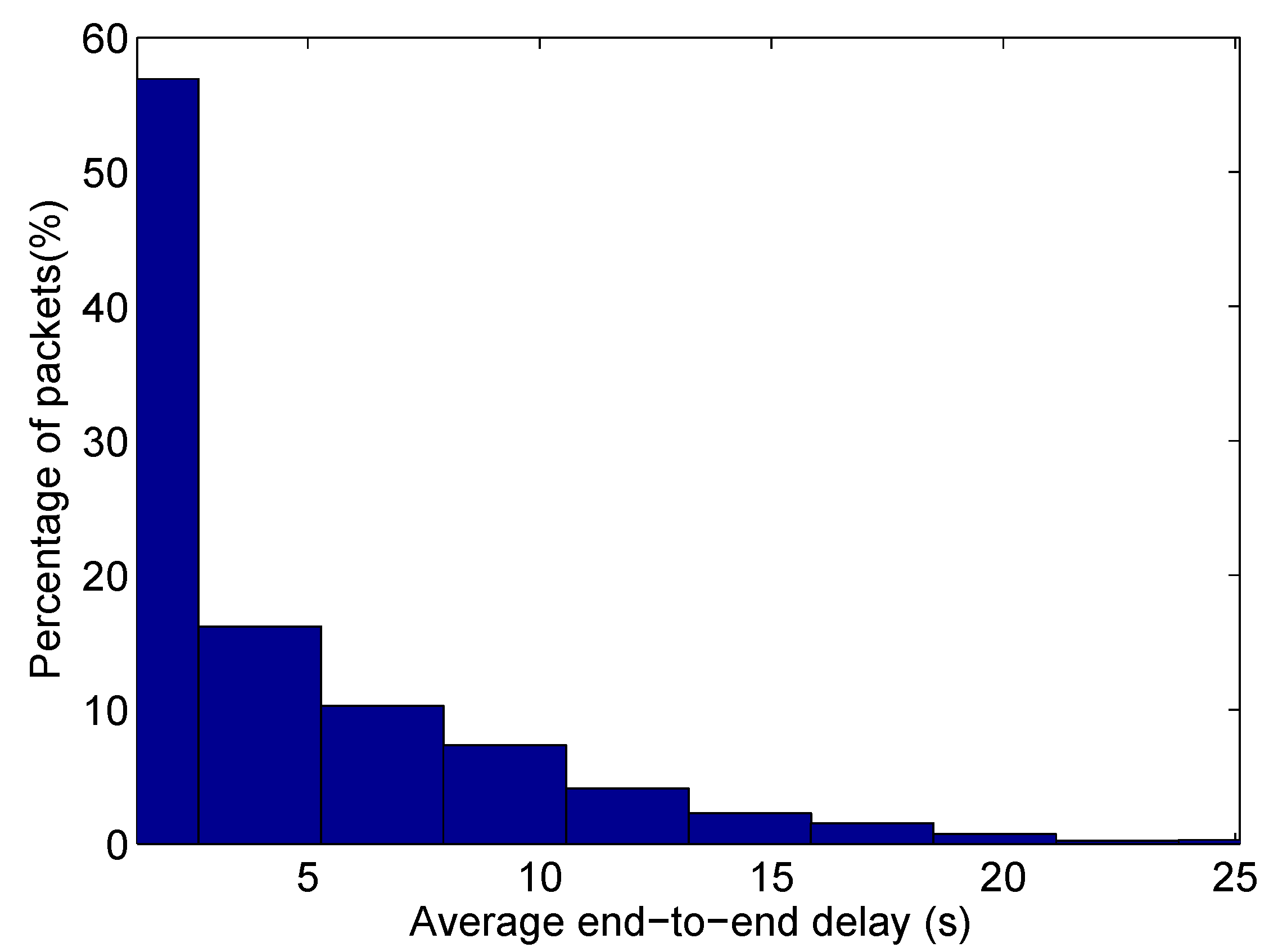
4.1. Effect of Sleep Modes on Packet Loss


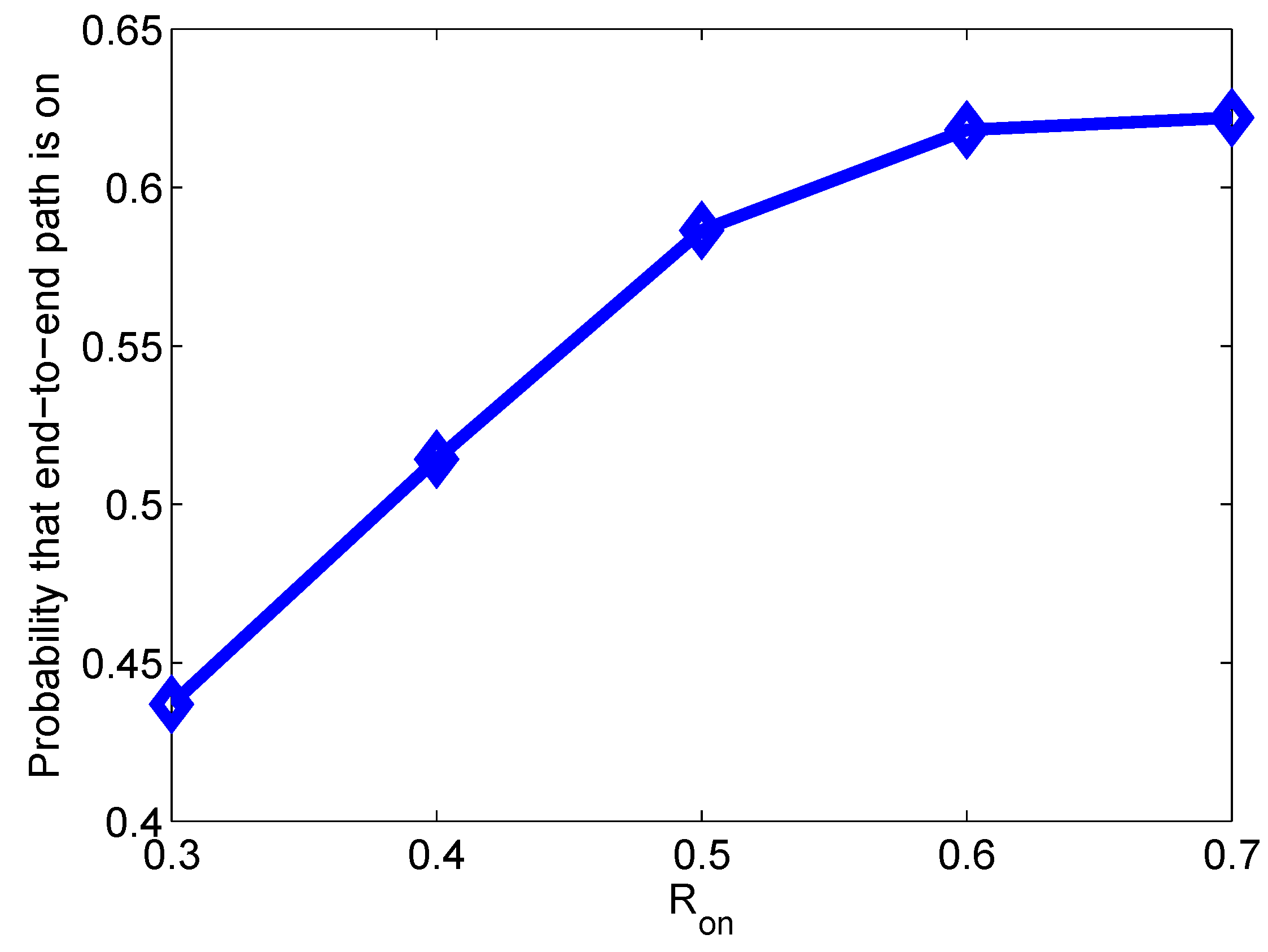
4.2. Power Consumption against Delay
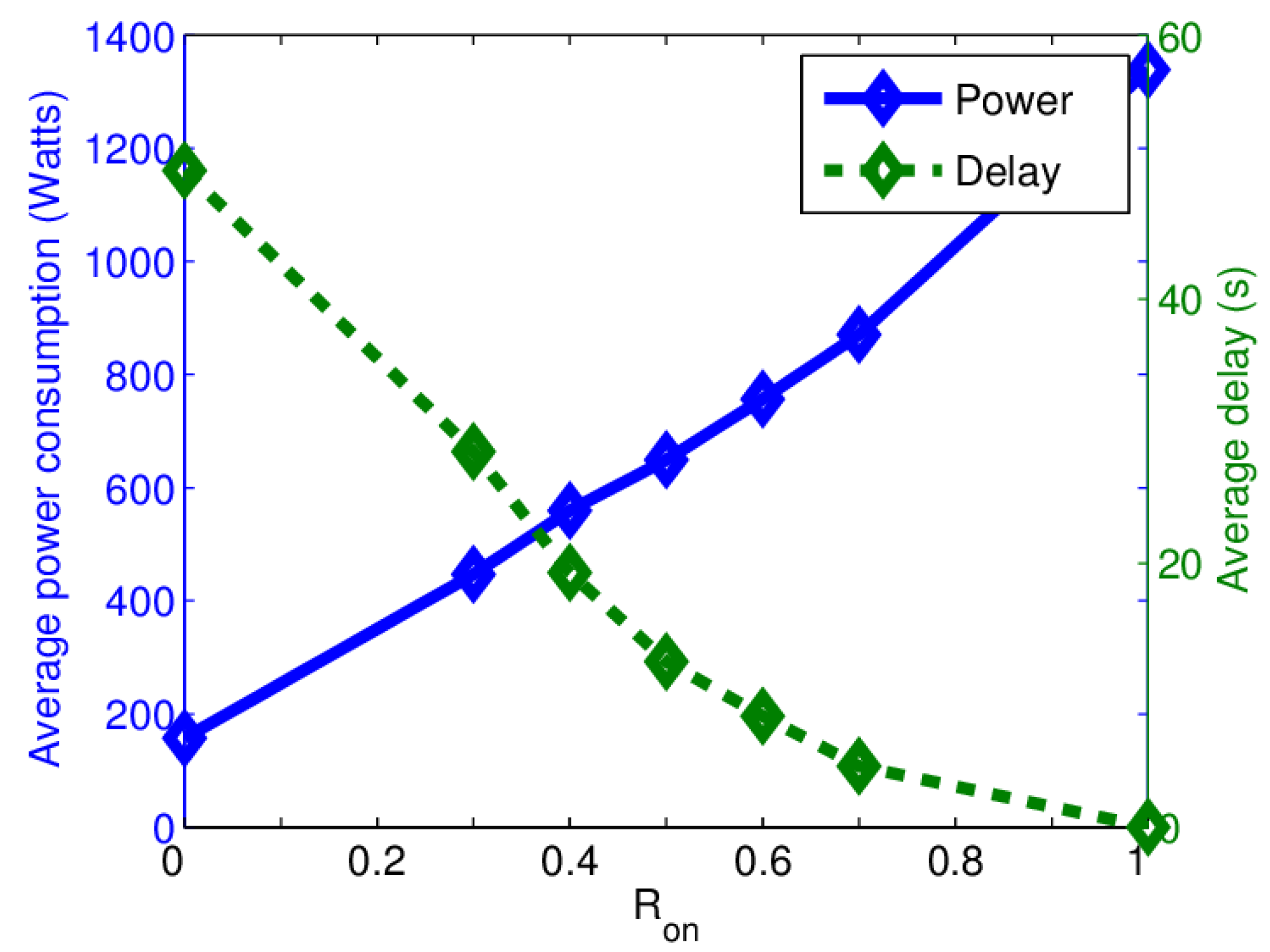
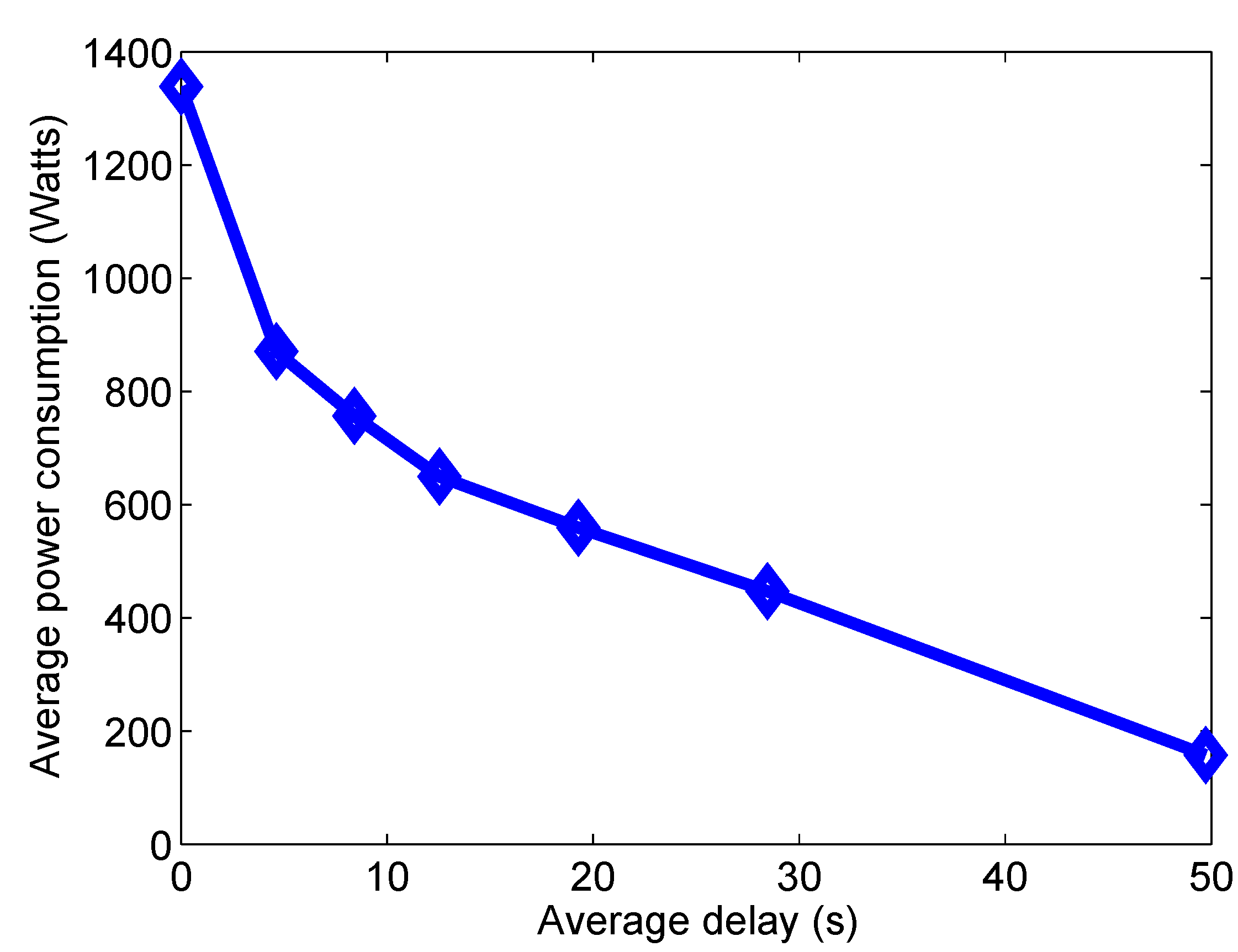
4.3. The Impact of the ON/OFF Cycle
| (s) | (s) | (s) | (s) | |
|---|---|---|---|---|
| experiment 1 | the nodes are always OFF | |||
| experiment 2 | 5 | 25 | 5 | 65 |
| experiment 3 | 5 | 35 | 5 | 55 |
| experiment 3 | 5 | 45 | 5 | 45 |
| experiment 5 | 5 | 55 | 5 | 35 |
| experiment 6 | 5 | 65 | 5 | 25 |
| experiment 7 | the nodes are always ON |
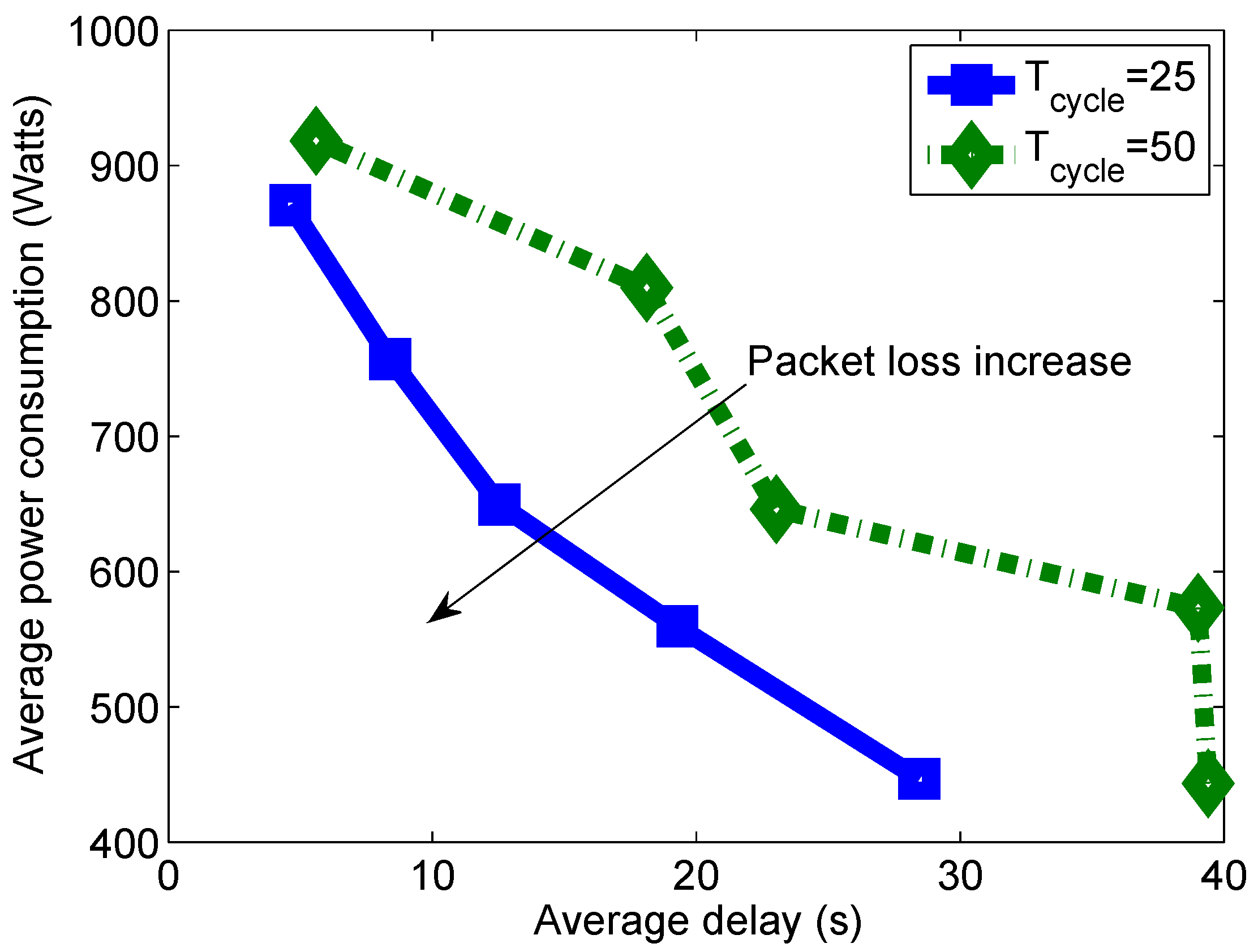
5. Conclusions
References
- Gartner, I. Gartner Estimates ICT Industry Accounts for 2 Percent of Global CO2 Emissions, 2007. Available online: http://www.gartner.com/newsroom/id/503867 (accessed on 14 May 2013).
- Vereecken, W.; van Heddeghem, W.; Deruyck, M.; Puype, B.; Lannoo, B.; Joseph, W.; Colle, D.; Martens, L.; Demeester, P. Power consumption in telecommunication networks: Overview and reduction strategies. Commun. Mag. IEEE 2011, 49, 62–69. [Google Scholar] [CrossRef]
- Gelenbe, E.; Lent, R. Power-aware ad hoc cognitive packet networks. Ad Hoc Netw. 2004, 2, 205–216. [Google Scholar] [CrossRef]
- Sakellari, G. The cognitive packet network: A survey. Comput. J. 2009, 53, 268–279. [Google Scholar] [CrossRef]
- Berl, A.; Gelenbe, E.; Girolamo, M.; Giuliani, G.; de Meer, H.; Dang, M.; Pentikousis, K. Energy-efficient cloud computing. Comput. J. 2010, 53, 1045–1051. [Google Scholar] [CrossRef]
- Sakellari, G.; Loukas, G. A survey of mathematical models, simulation approaches and testbeds used for research in cloud computing. Simul. Modell. Pract. Theory 2013, in press. [Google Scholar] [CrossRef]
- Zhang, Y.; Chowdhury, P.; Tornatore, M.; Mukherjee, B. Energy efficiency in telecom optical networks. IEEE Commun. Surveys Tutor. 2010, 12, 441–458. [Google Scholar] [CrossRef]
- Bianzino, A.; Chaudet, C.; Rossi, D.; Rougier, J.L. A survey of green networking research. Commun. Surv. Tutor. IEEE 2012, 14, 3–20. [Google Scholar] [CrossRef]
- Gelenbe, E.; Silvestri, S. Reducing Power Consumption in Wired Networks. In Proceedings of the 24th IEEE International Symposium on Computer and Information Sciences (ISCIS ’09), Guzelyurt, Northern Cyprus, 14–16 September 2009; pp. 292–297.
- Gelenbe, E.; Silvestri, S. Optimisation of Power Consumption in Wired Packet Networks. In Proceedings of the 6th International ICST Conference on Heterogeneous Networking for Quality, Reliability, Security and Robustness (QSHINE ’09), Las Palmas, Gran Canaria, 23–25 November 2009; Springer: Berlin, Germany, 2009; Volume 22, pp. 717–729. [Google Scholar]
- Adelin, A.; Owezarski, P.; Gayraud, T. On the Impact of Monitoring Router Energy Consumption for Greening the Internet. In Proceedings of the 11th IEEE/ACM International Conference on of the Grid Computing (GRID), Brussels, Belgium, 24–29, October 2010; pp. 298–304.
- Cianfrani, A.; Eramo, V.; Listanti, M.; Marazza, M.; Vittorini, E. An Energy Saving Routing Algorithm for a Green OSPF Protocol. In Proceedings of the INFOCOM IEEE Conference on Computer Communications Workshops, San Diego, CA, USA, 15–19 March 2010; pp. 1–5.
- Panarello, C.; Lombardo, A.; Schembra, G.; Chiaraviglio, L.; Mellia, M. Energy Saving and Network Performance: A Trade-off Approach. In Proceedings of the 1st International Conference on Energy-Efficient Computing and Networking, Passau, Germany, 13–15 April 2010; pp. 41–50.
- Gupta, M.; Singh, S. Greening of the Internet. Comput. Commun. Rev. 2003, 33, 19–26. [Google Scholar]
- Sakellari, G.; Morfopoulou, C.; Mahmoodi, T.; Gelenbe, E. Using Energy Criteria to Admit Flows in a Wired Network. In Proceedings of the 27th International Symposium on Computer and Information Sciences (ISCIS 2012), Paris, France, 3–5 October 2012; pp. 63–72.
- Gelenbe, E.; Morfopoulou, C. A framewok for energy aware routing in packet networks. Comput. J. 2011, 54, 850–859. [Google Scholar] [CrossRef]
- Gelenbe, E.; Mahmoodi, T. Energy-Aware Routing in the Cognitive Packet Network. In Proceedings of the International Conference on Smart Grids, Green Communications, and IT Energy-aware Technologies (Energy 2011), Venice, Italy, 22–27 May 2011.
- Gelenbe, E. Steps towards self-aware networks. Commun. ACM 2009, 52, 66–75. [Google Scholar] [CrossRef]
- Chabarek, J.; Sommers, J.; Barford, P.; Estan, C.; Tsiang, D.; Wright, S. Power Awareness in Network Design and Routing. In Proceedings of the IEEE INFOCOM 2008, Phoenix, AZ, USA, 13–18 April 2008; pp. 457–465.
- Mahadevan, P.; Sharma, P.; Banerjee, S. A Power Benchmarking Framework for Network Devices. In Proceedings of IFIP Networking, Aachen, Germany, 11–15 May 2009.
- Vasic, N.; Kostic, D. Energy-Aware Traffic Engineering; Technical Report for École polytechnique fédérale de Lausanne (EPFL): Lausanne, Switzerland, 2008. [Google Scholar]
- Nedevschi, S.; Popa, L.; Iannaccone, G.; Ratnasamy, S.; Wetherall, D. Reducing Network Energy Consumption via Sleeping and Rate-Adaptation. In Proceedings of the 5th Symposium on Networked Systems Design and Implementation, San Francisco, CA, USA, 16–18 April 2008; pp. 323–336.
- Chiaraviglio, L.; Mellia, M.; Neri, F. Reducing Power Consumption in Backbone Networks. In Proceedings of IEEE International Conference on the Communications, ICC’09, Dresden, Germany, 14–18 June 2009; pp. 1–6.
- Chiaraviglio, L.; Mellia, M.; Neri, F. Energy-Aware Backbone Networks: A Case Study. In Proceedings of IEEE International Conference on the Communications Workshops (ICC 2009), Dresden, Germany, 14–18 June 2009; pp. 1–5.
- Chiaraviglio, L.; Ciullo, D.; Leonardi, E.; Mellia, M. How Much Can The Internet be Greened? In Proceedings of 2009 IEEE GLOBECOM Workshops, Honolulu, HI, USA, 30 November–4 December 2009; pp. 1–6.
- Sanso, B.; Mellah, H. On Reliability, Performance and Internet Power Consumption. In Proceedings of the 7th International Workshop on Design of Reliable Communication Networks, Washington, DC, USA, 25–28 October 2009; pp. 259–264.
- Bianzino, A.; Chaudet, C.; Larroca, F.; Rossi, D.; Rougier, J. Energy-Aware Routing: A Reality Check. In Proceedings of the IEEE GLOBECOM Workshops (GC Wkshps), Miami, FL, USA, 6–10 December 2010; pp. 1422–1427.
- Bianzino, A.P.; Chiaraviglio, L.; Mellia, M.; Rougier, J.L. GRiDA: GReen Distributed Algorithm for energy-efficient IP backbone networks. Int. J. Comput. Telecommun. Netw. 2012, 56, 3219–3232. [Google Scholar] [CrossRef]
- Advanced Configuration and Power Interface Specification, Revision 5.0. Available online: http://www.acpi.info/spec.htm (accessed on 14 May 2013).
- Wattsup. Available online: https://www.wattsupmeters.com (accessed on 14 May 2013).
- Lieberman, P. Wake-on-LAN technology; Lieberman Software Corporation: Los Angeles, CA, USA, 2010. [Google Scholar]
- CESNET2 Network. Available online: http://www.ces.net/network/ (accessed on 14 May 2013).
- Perkins, C.; Royer, E. Ad-hoc On-demand Distance Vector Routing. In Proceedings of the Second IEEE Workshop on Mobile Computing Systems and Applications (WMCSA ’99), New Orleans, LA, USA, 25–26 February 1999; pp. 90–100.
© 2013 by the authors licensee MDPI, Basel, Switzerland. This article is an open access article distributed under the terms and conditions of the Creative Commons Attribution license ( http://creativecommons.org/licenses/by/3.0/).
Share and Cite
Sakellari, G.; Morfopoulou, C.; Gelenbe, E. Investigating the Tradeoffs between Power Consumption and Quality of Service in a Backbone Network. Future Internet 2013, 5, 268-281. https://doi.org/10.3390/fi5020268
Sakellari G, Morfopoulou C, Gelenbe E. Investigating the Tradeoffs between Power Consumption and Quality of Service in a Backbone Network. Future Internet. 2013; 5(2):268-281. https://doi.org/10.3390/fi5020268
Chicago/Turabian StyleSakellari, Georgia, Christina Morfopoulou, and Erol Gelenbe. 2013. "Investigating the Tradeoffs between Power Consumption and Quality of Service in a Backbone Network" Future Internet 5, no. 2: 268-281. https://doi.org/10.3390/fi5020268




